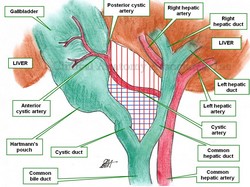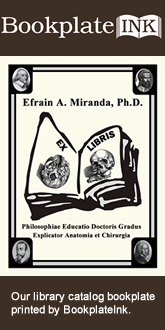
Image modified from the original
(Singh and Ohri, 2006
The [triangle of Calot], also known as the “cystohepatic triangle” is a triangular region found within the lesser omentum connecting the duodenum, stomach, and liver. It is an area bound superiorly by the inferior surface of the liver, laterally by the cystic duct and the medial border of the gallbladder, and medially by the common hepatic duct.
The surgical importance of this area is for a cholecystectomy. It is within this area that the surgeon will usually find the cystic artery, a critical structure that needs to be ligated in this procedure. I stress the term “usually” as the hepatobiliary tree is one of the areas in the human body that has the most anatomical variations. In fact, the anatomy in this region is considered to be “normal” only in 64% of the cases. The cystic artery may not be found in the triangle of Calot therefore careful dissection and identification of the structures is needed in every surgery.
The above description of the triangle of Calot is what some refer to as the “modern triangle of Calot”, as the original triangle described by Dr. Jean-Francois Calot (1861 – 1944) is different.
Calot’s original description of this triangle is: “Le triangle n’est pas exactement équilatéral, mais plutôt isocéle, les deux cotés supérieur et inférieur, représente par l’artére et le conduit cystique, étant seuls égaux, et un peu plus longs que la partie du canal hépatique qui entre dans la constitution du triangle’’ , which can be translated as: “ The triangle is not exactly equilateral, but rather an isosceles triangle. The superior and inferior sides, represented by the cystic artery and cystic duct, are equal and a little longer than the part of the hepatic duct, which enters into the formation of the triangle. (Abdalla, 2013).
In the accompanying image Calot’s original triangle is shown by horizontal blue lines while the modern version of the triangle of Calot is shown with vertical red lines.
Sources:
1. “Calot's triangle” Abdalla S, Pierre S, Ellis H. Clin Anat. 2013 May;26 (4):493-501
2. “Anatomic landmarks: their usefulness in safe laparoscopic cholecystectomy” Singh, K; Ohri, A. Surg Endosc (2006) 20: 1754–1758
3. “Surgical Anatomy” Deaver, J P. Blakiston's Son & Co. Philadelphia, 1901
4. "Tratado de Anatomia Humana" Testut et Latarjet 8th Ed. 1931 Salvat Editores, Spain
Image modified from the original (Singh and Ohri, 2006. Pastel sketch by Dr. E. Miranda



